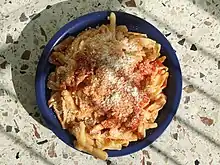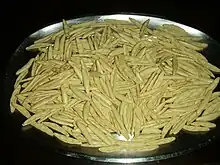Cavatelli
Cavatelli (/ˌkævəˈtɛli/ KAV-ə-TEL-ee, also US: /ˌkɑːv-/ KAHV-,[1][2][3] Italian: [kavaˈtɛlli]; literally "little hollows"[lower-alpha 1]) are small pasta shells made from semolina or other flour dough,[4] that resemble miniature hot dog buns,[5] commonly cooked with garlic and broccoli or rapini broccoli rabe, or simply with tomato sauce. A variant adds ricotta cheese to the dough mix.[5] Another variant with seafood is very popular in seaside cities and villages.

 Uncooked cavatelli | |
| Type | Pasta |
|---|---|
| Place of origin | Italy |
| Region or state | Molise, Apulia, Basilicata |

Regional names and varieties
Many varieties and local names of cavatelli exist, including orecchie di prete (priest's ears).[6] In Apulia, a number of varieties of cavatelli have specific names including pizzicarieddi.[6] A particular variety of cavatelli is typical of the area of Teggiano in Campania, where they are referred to as parmatieddi (or palmatielli). Parmatieddi are larger than cavatelli and flat-shaped. They are obtained by rolling a stick dough with three fingers of one hand, instead of with a single finger as done for the common cavatelli. Parmatieddi are usually served as a first course on Palm Sunday because their shape, similar to that of a tree leaf, recalls that of a palm.[6]
See also
References
- "cavatelli". The American Heritage Dictionary of the English Language (5th ed.). HarperCollins. Retrieved 29 May 2019.
- "cavatelli" (US) and "cavatelli". Lexico UK English Dictionary. Oxford University Press. Archived from the original on 27 April 2021.
- "cavatelli". Merriam-Webster.com Dictionary. Retrieved 29 May 2019.
- "Cavatelli". marcellinaincucina.com. 27 October 2020. Retrieved 7 June 2021.
- "Pasta Shapes". Cook's Thesaurus. Retrieved 29 July 2011.
- De Vita, Oretta Zanini (2009). Encyclopedia of Pasta. Berkeley: University of California Press. pp. 73, 195. ISBN 9780520944718.